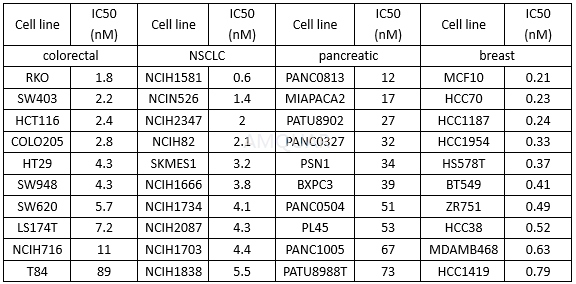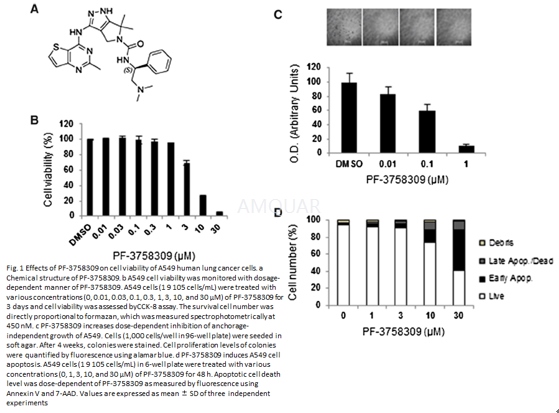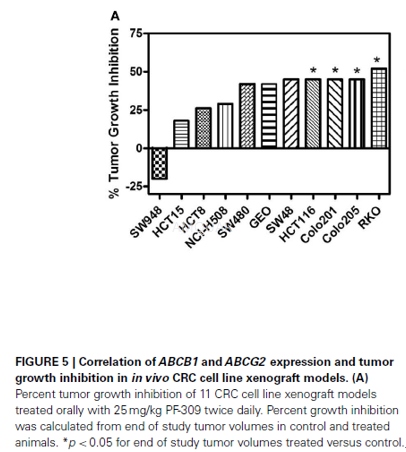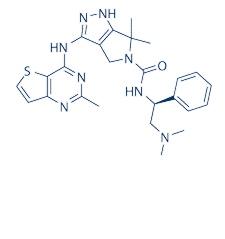-
生物活性
PF-3758309 is a inhbitor of PAKs with IC50 of 1.3 nM for PAK4; inhbits tumor growth in HCT116, A549, M24met and other xenograft tumor models.PF-3758309, a potent (K(d) = 2.7 nM), ATP-competitive, pyrrolopyrazole inhibitor of PAK4. In cells, PF-3758309 inhibits phosphorylation of the PAK4 substrate GEF-H1 (IC(50) = 1.3 nM) and anchorage-independent growth of a panel of tumor cell lines (IC(50) = 4.7 +/- 3 nM). Experiments using PF-3758309 confirm that inhibiting PAK is a beneficial strategy to combat some tumors, and this activity is likely related to modulation of both cell proliferation and survival.
Inhibitionof PAK isoforms by PF-3758309[1][2]

Kinaseinhibition of PF-3758309[1]

Antiproliferativeactivity[1]

-
体外研究
-
体内研究
-
激酶实验
Invitro Kinase Assays
For the assays of PAK1 or PAK2transphosphorylation of PKD1 on Ser203, 200ng of recombinant PKD1was incubated in the absence or in the presence of 50ng of recombinant activePAK1 or 50ng of recombinant active PAK2 in 25μl of kinase buffer (10μM ATP,25mM MOPS, pH 7.2, 12.5mM, glycerol 2-phosphate, 25mM MgCl2, 5mMEGTA, and 2mM EDTA and 0.25mM DTT) for 5 min at 30 ℃. Reactions wereterminated by addition of 2× SDS-PAGE sample buffer and resolved by SDS-PAGE.PKD1 phosphorylation was determined by Western blot analysis using the antibodythat detects its phosphorylated state on Ser203. The active PAK1 wasgenerated by incubating a mixture PAK1/CDC42 in 10μl kinase buffer with 5μl of12.5mM MnCl2/0.5mM GTP solution and incubated for 20 min at 30oCprior to the addition of 10μl of PKD1 (200ng).
-
细胞实验
Cellculture[4]
A549 human adenocarcinoma cells werecultured in Dulbecco’s modified Eagles’s medium supplemented with 10 % fetalbovine serum, 100 U/mL of penicillin, and 100 mg/mL streptomycin mixedantibiotics. A549 cells were maintained at 37 ℃ in a humidifiedatmosphere of 5 % CO2–95 % air. The stock solution of PF-3758309 wasdissolved in DMSO. Appropriate amounts of stock solution (10 mM in DMSO) ofPF-3758309 were added to the cultured medium to achieve the incubatedconcentrations (final DMSO concentration was<0.3 %).
Analysisof cell viability
CCK-8 assay was performed to determine cellviability. Cells were seeded at a density of 104 cells per well into96-wellplates with 10 % fetal bovine serum and incubated for 24 h. Then, cells weretreated with PF-3758309 at various concentrations (0, 0.01, 0.03, 0.1, 0.3, 1,3, 10, and 30μM) for 3 days. After the exposure period, the medium was changed andincubated with CCK-8 solution (10 % of the total volume) /well for30 min. Themedium was measured spectrophotometrically at 450 nm and the percentage ofviable cells was estimated by comparison with the 0.3 % DMSO control cells.
Apoptosisand cell death assay
For PF-3758308-induced apoptotic celldeath, A549 cells were seeded at a density of 1x105cells/mLin a 6-well plate for 24 h and treated with various concentrations (0, 1, 3,10, and 30μM) of PF-3758309 for 48 h before apoptosis detection. Apoptosis wasassessed by MUSE cell analyzer according to the manufacturer’s protocol. Inbrief, cells were harvested with trypsin–EDTA (0.25 % trypsin, 0.02 %) andfreshly prepared1 % serum-containing medium was added to each sample to obtaina final cell concentration of 1x105cells/mL. The prepared cells werelabeled with Annexin V and7-Aminoactinomycin D (7-AAD) for 20 min at room temperature(RT) in the dark and apoptotic cells were detected. All apoptosis analyses wereperformed in triplicates.

-
动物实验
Animals[5]
Female 5–6-week-old athymic nude mice were housed(three to five per cage) in polycarbonate cages and kept on a 12h light/dark cycle.Animals were allowed to acclimate for at least 7days before any handling. Food andwater were given ad libitum.
Cellline xenografts
CRC cells were harvested in exponential phasegrowth and resuspended in a 1:1 mixture of serum-free RPMI 1640 and Matrigel. Fiveto ten million cells per mouse were injected subcutaneously in to the flank usinga 23-gaugeneedle. Mice were monitored daily for signs of toxicity and were weighedtwice weekly. Tumor size was evaluated twice perweek by caliper measurements usingthe following formula: tumor volume=lengthxwidth2x0.52. When tumors reached200–300mm3 mice were randomized into two groups with at least 10tumors per group. Mice were then treated for 14–28days (until control tumor volumereach ~1500mm3) with either vehicle control (0.5% methylcellulose), orPF-3758309 (25mg/kg) twice daily by oral gavage.

-
不同实验动物依据体表面积的等效剂量转换表(数据来源于FDA指南)
|  动物 A (mg/kg) = 动物 B (mg/kg)×动物 B的Km系数/动物 A的Km系数 |
|
例如,已知某工具药用于小鼠的剂量为88 mg/kg , 则用于大鼠的剂量换算方法:将88 mg/kg 乘以小鼠的Km系数(3),再除以大鼠的Km系数(6),得到该药物用于大鼠的等效剂量44 mg/kg。
-
参考文献
[1] Murray BW GC, Piraino J, Westwick JK, Zhang C, Lamerdin J, Dagostino E, Knighton D, Loi CM, Zager M, Kraynov E, Popoff I, Christensen JG, Martinez R, Kephart SE, Marakovits J, Karlicek S, Bergqvist S, Smeal T. Small-molecule p21-activated kinase inhibitor PF-3758309 is a potent inhibitor of oncogenic signaling and tumor growth. Proc Natl Acad Sci U S A. . 2010 107(20):9446-9451.
[2] Senapedis W CM, Baloglu E, Landesman Y. Therapeutic Potential of Targeting PAK Signaling. Anticancer Agents Med Chem. . 2016;16(1):75-88.
[more]
分子式
C25H30N8OS |
分子量
490.62 |
CAS号
898044-15-0 |
储存方式
﹣20 ℃冷藏长期储存。冰袋运输 |
溶剂(常温)
|
DMSO
200 mM |
Water
<1 mg/mL |
Ethanol
200 mM |
体内溶解度
-
Clinical Trial Information ( data from http://clinicaltrials.gov )
注:以上所有数据均来自公开文献,并不保证对所有实验均有效,数据仅供参考。
-
相关化合物库
-
使用AMQUAR产品发表文献后请联系我们






















